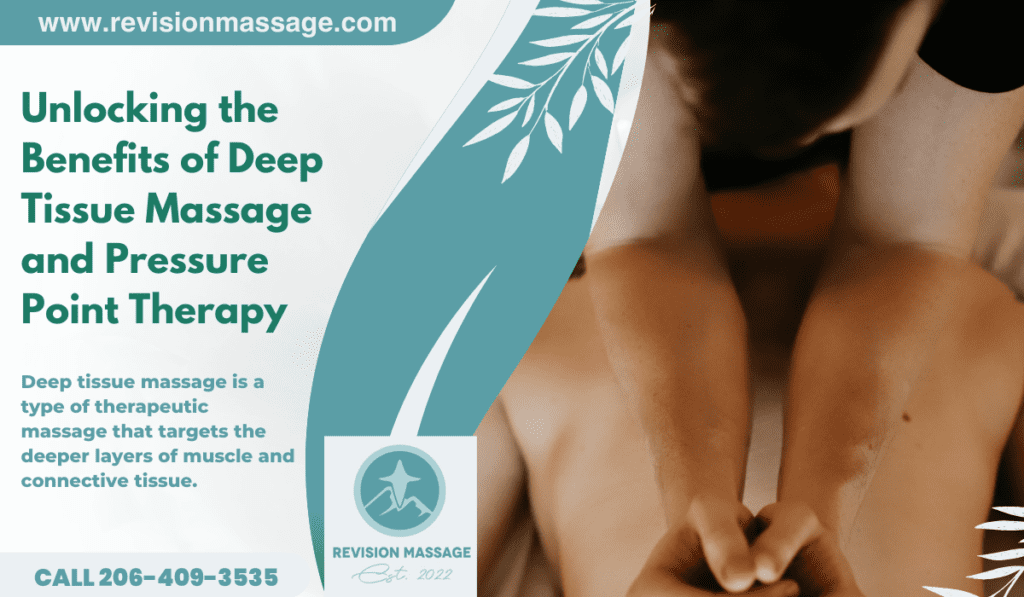Revision Massage in Monroe: Deep Tissue Massage and Pressure Point Therapy for Healing and Improved Well-Being for Clients with Injuries, Chronic Pain, and Mental Health Challenges
Deep tissue massage is a type of therapeutic massage that targets the deeper layers of muscle and connective tissue. This type of massage uses firm pressure and slow strokes to reach these deeper layers and release chronic muscle tension, adhesions, and knots.
During a deep tissue massage, the therapist will use their hands, fingers, forearms, and elbows to pressure and manipulate the muscles. This technique can be intense and may cause discomfort, but the massage therapist will work to ensure you are comfortable and the pressure is appropriate for your needs.
Deep tissue massage is different from other types of massage in several ways:
- Pressure: Deep tissue massage uses more pressure than other types of massage, such as Swedish or relaxation. This pressure is necessary to reach the deeper muscle and connective tissue layers.
- Technique: The massage therapist will use slow strokes and deep pressure to manipulate the muscles and reach the deeper layers of tissue. This technique differs from the lighter, more relaxing strokes in Swedish massage.
- Focus: Deep tissue massage targets specific areas of tension or pain in the body rather than providing an overall relaxing experience. It often treats chronic pain, injury, or postural problems.
- Communication: Communication between the massage therapist and client is essential during a deep tissue massage. The massage therapist will work with you to determine the appropriate pressure and adjust the technique to ensure comfort.
- After-effects: Deep tissue massage may leave you feeling sore or tender for a day or two after the massage, but this is normal and will subside. Drinking plenty of water after the massage is important to help flush out muscle toxins.
Deep tissue massage is a therapeutic massage that uses firm pressure and slow strokes to reach the deeper layers of muscle and connective tissue. It differs from other types of massage in its pressure, technique, focus, communication, and after-effects. Deep tissue massage effectively treats chronic pain, injury, and postural problems.
Benefits of Deep Tissue Massage
Deep tissue massage is a highly beneficial form of therapeutic massage that offers a wide range of benefits for both the body and the mind. It is an effective way to relieve chronic pain in areas such as the neck, shoulders, back, and legs, by releasing tension and knots in the muscles and connective tissue. Deep tissue massage can also improve flexibility by loosening tight muscles and fascia, which can enhance range of motion and prevent injuries.
Additionally, deep tissue massage can have a relaxing effect on the body, helping to reduce stress and anxiety, while promoting the release of endorphins, which are natural mood-boosting chemicals. By correcting muscle imbalances and improving overall posture, deep tissue massage can also help to prevent injuries and improve athletic performance.
Furthermore, deep tissue massage has been shown to lower blood pressure in individuals with hypertension, which can have significant health benefits. However, it is important to note that deep tissue massage may not be suitable for everyone, especially those with certain medical conditions or injuries. Therefore, it is recommended to consult with a healthcare provider before receiving deep tissue massage, especially if you have any medical concerns or are undergoing medical treatment.
Overall, deep tissue massage works by releasing tension and knots in the muscles and connective tissue, which can provide relief from pain, improve range of motion, and promote relaxation and well-being.
Trigger Point Therapy
Trigger point therapy is a form of massage therapy that involves applying pressure to specific points in the body known as trigger points. Trigger points are areas of muscle that have become tense and may be causing pain or discomfort.
During trigger point therapy, the massage therapist applies pressure to these points using their fingers, knuckles, or elbows. The pressure is usually firm and sustained, and may be accompanied by stretching or range of motion exercises.
Trigger point therapy can be used to treat a variety of conditions, including headaches, neck and shoulder pain, low back pain, and fibromyalgia. By releasing tension in the trigger points, trigger point therapy can help to reduce pain, improve range of motion, and promote relaxation and well-being.
Trigger point therapy is often used in combination with other forms of massage therapy, such as deep tissue massage or Swedish massage, and can be tailored to meet the individual needs and preferences of the client. It is important to communicate with the massage therapist throughout the session to ensure that the pressure is not too much and to address any concerns or questions you may have.
Trigger Point Therapy can offer several benefits, including:
- Pain relief: Trigger point therapy can help to relieve pain and discomfort in specific areas of the body. By releasing tension in the trigger points, the therapy can help to reduce pain caused by muscle tension, injuries, or chronic conditions.
- Improved range of motion: Trigger point therapy can help to improve range of motion and flexibility by releasing tight muscles and increasing blood flow to the affected areas.
- Stress relief: Trigger point therapy can help to promote relaxation and reduce stress levels. By releasing tension in the muscles, the therapy can help to calm the nervous system and promote a sense of well-being.
- Headache relief: Trigger point therapy can be effective in reducing tension headaches and migraines. By releasing tension in the muscles of the head and neck, the therapy can help to alleviate headache pain.
- Improved circulation: Trigger point therapy can improve circulation to the affected areas, which can help to promote healing and reduce inflammation.
- Improved athletic performance: Trigger point therapy can help to improve athletic performance by increasing flexibility and range of motion, reducing muscle soreness and tension, and promoting faster recovery after exercise or competition.
Overall, trigger point therapy can be an effective treatment option for those experiencing pain or discomfort in specific areas of the body, and can help to promote relaxation and well-being. It is important to communicate with a trained massage therapist to determine if trigger point therapy is the right treatment for you.
Why Revision Massage is the right choice for deep tissue massage.
Revision Massage is an excellent choice for those seeking high-quality massage services from a Licensed Massage Therapist with extensive experience in helping clients achieve their wellness objectives.
Travis is proficient in deep tissue massage techniques and is renowned for his friendly, approachable demeanor. He takes a personalized approach, taking the time to understand each client’s unique requirements and tailoring each session accordingly.
If you want a massage therapist who will actively listen to your needs and work with you to achieve your wellness goals, Revision Massage is the perfect destination. Don’t hesitate to schedule an appointment today and experience the benefits of Travis’s expertise firsthand.

